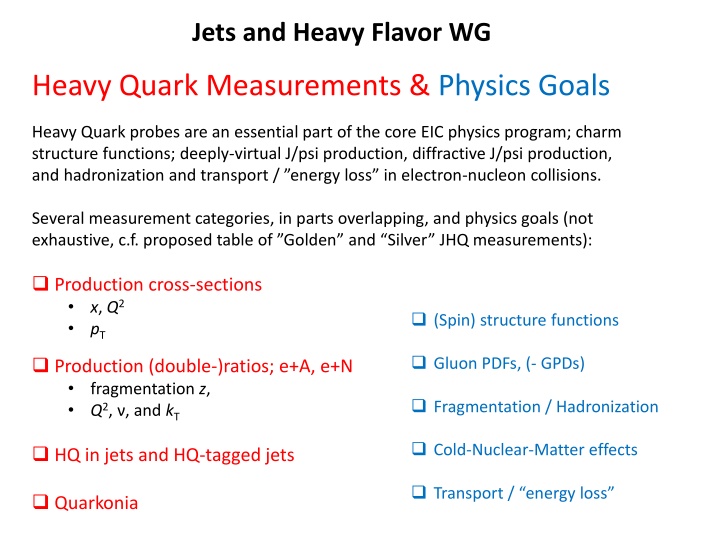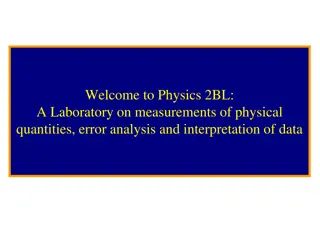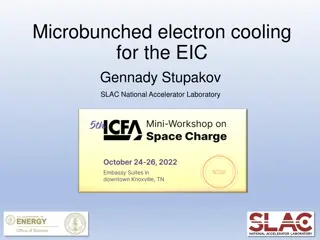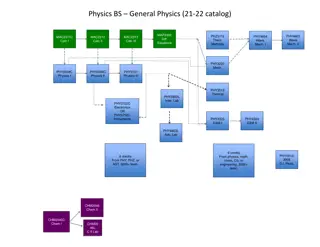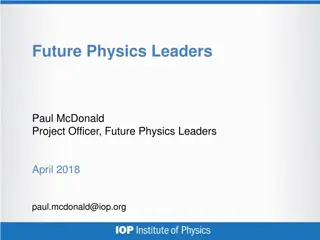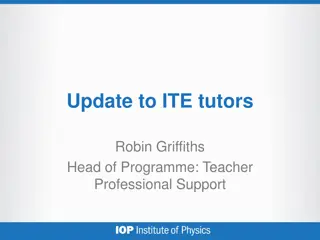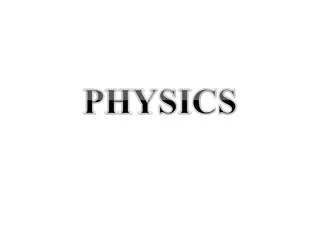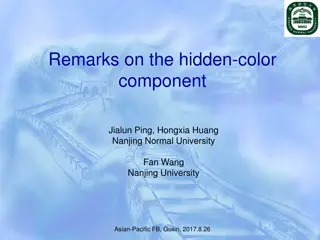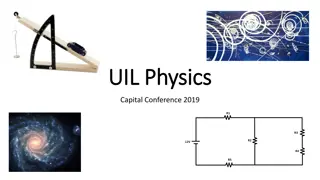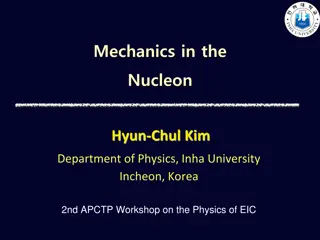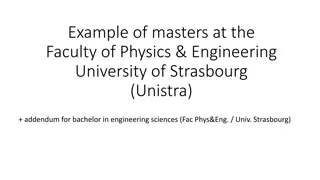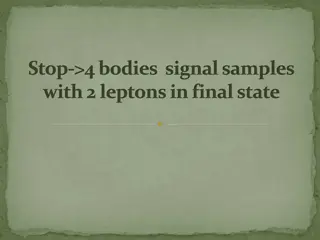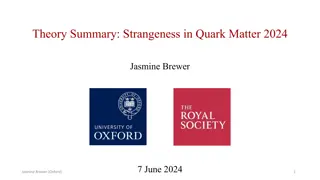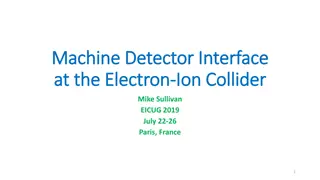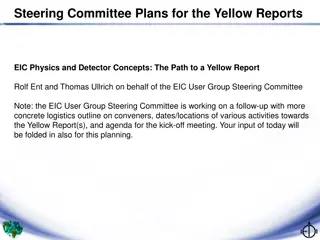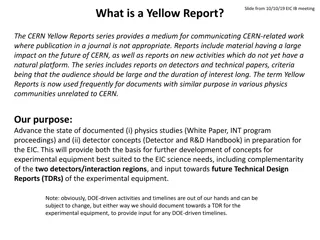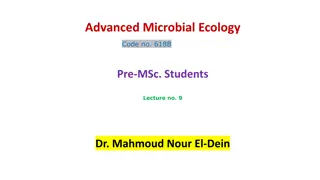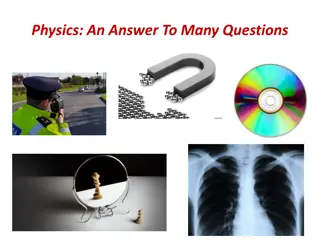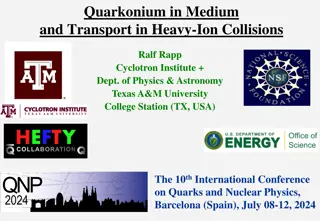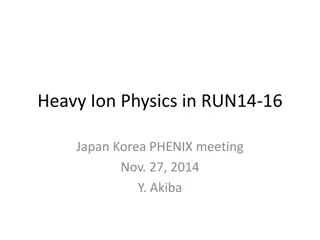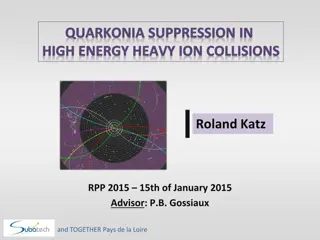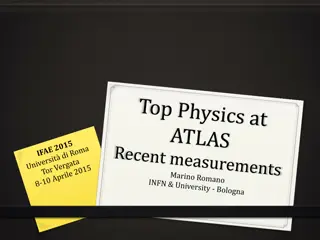Heavy Quark Measurements & Physics Goals at EIC
Jets and Heavy Flavor Working Group explores essential heavy quark probes in EIC physics with goals like charm structure functions, J/psi production, and hadronization. The detector considerations and jet measurements play crucial roles in achieving these physics objectives.
Download Presentation

Please find below an Image/Link to download the presentation.
The content on the website is provided AS IS for your information and personal use only. It may not be sold, licensed, or shared on other websites without obtaining consent from the author.If you encounter any issues during the download, it is possible that the publisher has removed the file from their server.
You are allowed to download the files provided on this website for personal or commercial use, subject to the condition that they are used lawfully. All files are the property of their respective owners.
The content on the website is provided AS IS for your information and personal use only. It may not be sold, licensed, or shared on other websites without obtaining consent from the author.
E N D
Presentation Transcript
Jets and Heavy Flavor WG Heavy Quark Measurements & Physics Goals Heavy Quark probes are an essential part of the core EIC physics program; charm structure functions; deeply-virtual J/psi production, diffractive J/psi production, and hadronization and transport / energy loss in electron-nucleon collisions. Several measurement categories, in parts overlapping, and physics goals (not exhaustive, c.f. proposed table of Golden and Silver JHQ measurements): Production cross-sections x, Q2 pT (Spin) structure functions Gluon PDFs, (- GPDs) Production (double-)ratios; e+A, e+N fragmentation z, Q2, , and kT Fragmentation / Hadronization Cold-Nuclear-Matter effects HQ in jets and HQ-tagged jets Transport / energy loss Quarkonia
Detector Considerations Although we do not yet have detailed performance requirements driven by physics goals, some general considerations and needs can be stated: The charm to DIS cross-section, for example, is 2 3% at Bjorken-x ~0.1, Many heavy-quark decay channels are multi-particle; Low measurement thresholds (typically at least decay-particle is soft ) Minimize acceptance gaps (PID purity) Wide charged particle tracking acceptance -4 < < 4 Positive and robust PID; > - 1, wide p Precision vertexing up to 2.5 3.5 in ; 20x20 m pixels appear reasonable Spin measurements, in particular, suffer from background subtractions A few points on vertexing: Displacements can be 2-dimensional or 3-dimensional Use a beam-line constraint or reconstructed primary vertex Some questions / discussion points: Trade-offs between measurement thresholds and momentum resolution (B) Trade-offs between innermost barrel-length and disk positions, PID in higher density particle environment(s), e.g. forward e+A, Muon chambers (?)
Jet Measurements - Examples Dijet ALL Hadron-in-Jet Lepton-Jet Correlations Jet Substructure
Jet Measurements & Physics Goals Jets have the potential to address a wide range of physics topics, often in ways complimentary to inclusive or SIDIS based approaches Several categories of measurements roughly organized by increasing demands on detector and some associated physics goals (not exhaustive see Table of Measurements for more detail) Inclusive measures: Cross Sections Spin Asymmetries Helicity Distributions PDFs Correlation measures: Dijet Azimuthal Correlations Lepton-Jet Azimuthal Correlations TMDs Quark / Gluon Sivers Nuclear Broadening Fragmentation / Hadronization CNM Effects Collins Fragmentation Transversity Energy Distributions: Substructure Hadron-in-Jet
Detector Considerations Although we do not yet have detailed performance requirements driven by physics goals, some general needs can be stated: Tracking and calorimeter (electromagnetic and hadronic) coverage in range -4 < < 4 Minimize acceptance gaps Robust PID for particles in jet There are a number of points to keep in mind about jets at an EIC: These will be low momentum/energy objects tracking resolution will always be superior to hadron calorimetry Jets will be relatively sparse, containing roughly 10-12 particles in R=1.0 at highest pT Some questions / discussion starters for the detector experts: What is the tradeoff between B-field strength (low momentum particle acceptance) and momentum resolution What kind of position resolution is achievable in calorimeters and how does that relate to granularity What are realistic resolutions for hadron calorimeters What level of PID (degree of separation between pion, kaon, proton) is achievable in jet environment
Example arXiv:2002.05880 Workflow Start with a physics question: differentiate between hadronization inside nuclear matter (dashed lines) and energy loss of partons, hadronization outside (solid lines). Constrain the transport properties of large nuclei Theory framework and phenomenological studies the right observable, cm energy, kinematic coverage, sensitivity Not discussed here, for the example see talk by Z. Liu in the joint J&HF and SIDIS session Reconstructed cluster mass with K Reconstructed cluster mass with K Reconstructed cluster mass with K Reconstructed cluster mass with K Focus on D-mesons 5000 5000 w/ LANL FST MC w/ LANL FST D D SIG/BKG: 1.510 ) SIG/BKG: 1.360 D ( MC 0 0 4000 4000 Rec. D s Total fit s s D ( D ) SIG/BKG: 0.670 0 0 Rec. D ( D ) 3000 3000 Rec. D Q2 > 25 GeV2 Optimized stand-alone detector 1000 1< <4 2000 2000 1000 CM energy 69 GeV (slightly higher) 1.83 1.84 1.85 1.86 1.87 1.88 1.89 1.9 GeV/c 1.91 2 1.94 1.95 1.96 1.97 1.98 1.99 2 2 GeV/c 6
Identifying and reconstructing the final states Mass peak reconstruction > momentum resolution -> material budget Decay length -> vertex resolution - > pixel pitch size and detector design (# of layers) Collision frequency -> trigger integration times Kinematic coverage optimized hadronization and charm content of example, more forward rapidity Signal/Background VS pixel pitch Signal/Background VS pixel pitch Signal/Background VS Material budget per layer Signal/Background VS Material budget per layer 2 2.2 Sig/Bkg Sig/Bkg Material per layer: 0.4%X trigger rate: 500 kHZ Sig/Bkg ratio D 0 D D Sig/Bkg ratio D 0 D D 2 0 1.8 1.8 1.6 0 0 ( D ) ( D ) 1.6 1.4 s s 1.4 1.2 1.2 1 1 0.8 0.8 0.6 0.6 0.4 0.4 Pixel pitch: 30 micron Trigger rate: 500 kHZ 0.2 0.2 0 0 0 0.2 0.4 0.6 0.8 1 1.2 ) 0 0 20 40 60 80 100 120 140 160 180 200 220 Material budget per layer (% X Pixel pitch (micron) Material budget has larger effect than pixel size Projected p Projected p dependent impact parameter b dependent impact parameter b resolution resolution T T T T 3 10 m) m resolution ( Impact parameter b p in FST = 1.5 h = 2 h = 2.5 h = 3 h = 3.5 h = 4 h First have detector concept to optimize The full analysis framework which includes the event generation (PYTHIA8), detector response in fast simulation, beam remnant interaction background embedding, and hadron reconstruction have been set up 2 10 T 10 0 2 4 6 8 10 12 14 16 18 p 20 22 p (GeV/c) T ~ 50 micron or better transverse resolution 7
Full simulation / current status Full simulation: example EICROOT, BABAR magnet configuration, BEAST integration forward detectors highlighted - for our group we have to see what additional requirements e+A might impose Electron-Cu event LANL FST + GEMS +MAPS ePythia: Electron (20 GeV), proton (250 GeV). Q2>0.8 GeV/c2 , no radiative corrections. DpmJetHybrid: Electron (10 GeV), proton (100 GeV). Q2>1 GeV/c2 , no radiative corrections. Get better that 1% momentum resolution Full simulation: feedback to fast simulation if needed 8
